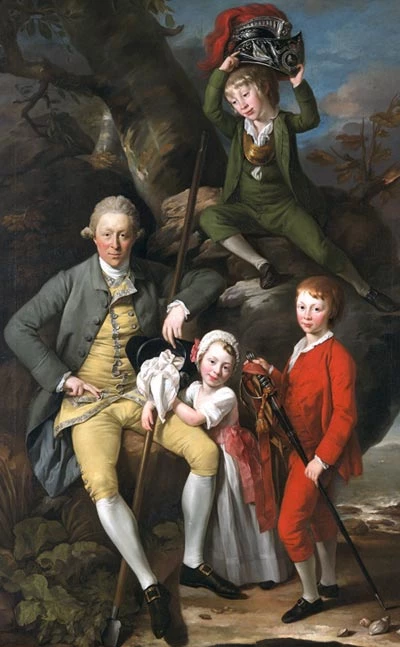A portrait of a Welsh Squire and his children, by Johann Zoffany, distinguished painter to George III
There are many portraits of well-known Welsh figures in the art collections of Angueddfa Cymru. However, the Museum also collects portraits of lesser-known people as they can be important works of art in their own right. The study of these portraits often sheds new light on when and how their subjects lived and adds to our understanding of art in the past.
During the past 20 years several distinguished 18th and early 19th century portraits have been acquired by the Museum, including Henry Knight of Tythegston with his three children, painted by Johann Zoffany (1733-1810) in about 1770.
Henry Knight of Tythegston with his three children by Johann Zoffany
Johann Zoffany (1733-1810)
Henry Knight of Tythegston (1738-1772) with his Children. c.1770 - oil on canvas
The portrait shows the Glamorganshire squire Henry Knight (1738-1772) with his three children Henry, Robert and Ethelreda. Henry was a soldier in the 15th Light Dragoons, and his older son is shown trying on a helmet of that regiment. Henry Knight's father, Robert Knight (1711-1765), inherited the Tythegston estate of the Lougher family through his mother in 1732. Henry divorced from his wife in 1771, then a difficult and expensive process requiring a private Act of Parliament. The painting might have been commissioned to represent Henry Knight's decision to leave the military in order to care for his children. In the picture, he is dressed in civilian clothes, but he holds an infantry officer's spontoon, thrust blade-first into the ground. His sons hold his sword, gorget and helmet. The picture's seaside setting is probably a reference to Tythegston, a couple of miles from the coast, between Bridgend and Porthcawl. The tree motif, frequently used in Zoffany's family groups, allows all the figures to be given equal importance. Showing the boys playing with arms and armour belongs to a tradition that can be traced back to the Renaissance.
Johann Zoffany
This is one of Zoffany's largest family portraits (measuring 240 cm x 149 cm), and is a surprisingly ambitious commission for a Welsh squire of modest means. Zoffany, one of the most distinguished British painters of the reign of George III, was famous for his informal styles. One of his best-known pictures, Sir Lawrence Dundas with his grandson, shows the 17th century Dutch masterpiece The Calm by Jan van de Cappelle, also in the Museum's collections.
Born near Frankfurt and trained in Rome, Zoffany moved to London in 1760. Lord Bute, George III's first prime minister, probably introduced him to the Royal Family, where he became the favourite painter of Queen Charlotte. The King nominated him a member of the Royal Academy in 1769. The appeal of Zofanny's work lies in his ability to catch a likeness and his astonishing attention to detail. His perspective, however, can be faulty, and here the helmet held by the older son is clearly too large.
Purchasing the portrait for the Museum
The picture is in a remarkably good state of preservation. X-ray examination reveals that the artist reworked the head of Robert Knight (the younger son dressed in red), but there are only a few other minor changes to the design, and most of the composition was laid on quite thinly. The picture was loaned to the Museum from 1940 until 1958. When it was offered for sale at Sotheby's in 1999 its acquisition by the Museum was a priority. The purchase was made possible by generous donations from the bequest of June Tiley, the Heritage Lottery Fund and the National Art Collections Fund.
